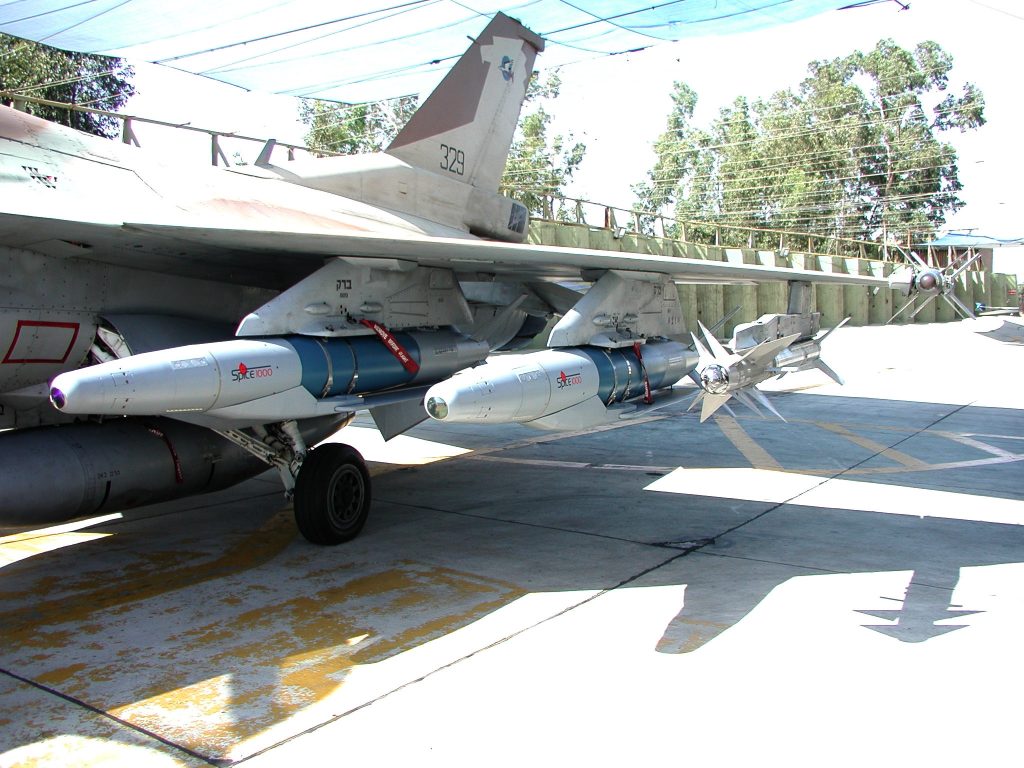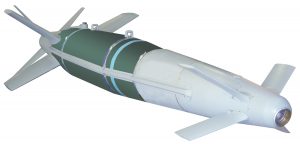
SPICE 1000 on F-16
CORRECTED bombload of F-16 TEL AVIV: Israeli company Rafael Advanced Defense Systems and Lockheed Martin have signed a cooperation agreement to develop, market, manufacture and support the Israeli company’s SPICE smart bombs.
SPICE — a somewhat tortured acronym meaning “Smart, Precise Impact and Cost-Effective” — was used by the Israeli Air Force (IAF) to destroy an Iranian facility in Syria, when Russian troops were very close to the target. According to the Lebanese press, parts of SPICE bombs were found in sites attacked by Israel.
The critical need to hit the enemy but not even scratch nearby friendly military forces is a major consideration in Syria, where the IAF has performed more than 200 such strikes on Iranian facilities built to upgrade the rockets which Tehran then transfers to Hezbollah in Lebanon.
The “Americanization” of the SPICE bombs will allow Lockheed Martin to offer it to all its customers, mainly operators of F-16 and F-35 fighter aircraft, according to Gideon Weiss, deputy general manager of Rafael’s marketing and business development, air and C4I systems division.
“Now the Americans use the high-end weapons systems like the AGM-158 air launched cruise missile, and the low-end systems, like the Paveway LGB bombs — these require a laser designator to illuminate the target. In the gap between those two types of weapon systems, the SPICE is a very good solution,” the Rafael executive told Breaking Defense.
This partnership may not mean many new jobs in the US since some 80 percent of the Spice bombs are already manufactured in a Rafael facility in Florida. This allows the IAF to buy these advanced weapon systems using U.S Foreign Military Financing (FMF) money.
The IAF plans to equip its F-35I Adir with Israeli-developed weapons systems. There is no doubt that the SPICE family is high on the priority list. If and when these bombs are operational on the IAF’s F-35s, Lockheed Martin will be able to offer them to F-35 users around the world.
The agreement was signed between Rafael and LM ‘s missiles and fire control division, but Israeli sources say the aim is to use the full capabilities of the American company to promote the Israeli smart bombs in the international market.
The Rafael SPICE 1000 and SPICE 2000 guidance kits convert 1,000 lb and 2,000 lb general purpose and penetration warheads into precision stand-off strike weapons. The SPICE-1000 kit has a stand-off range of 62 miles for general purpose or penetration warheads, such as the MK-83 and RAP1000.

SPICE 2000
The SPICE-2000 kit boasts a stand-off range of 37 miles for general purpose or penetration warheads, such as the MK-84, RAP2000 and BLU-109.
Mission planning for the SPICE family members can be performed in the air or on the ground, and uses target coordinates, impact angle and azimuth, imagery and topographical data to create a mission for each target, says Yuval Miller, Rafael’s executive vice president and the head of the company’s air & C4ISR systems division.
The pilot allocates a mission to each weapon before release. The weapon is released outside the threatened area and heads autonomously towards the target zone. As the weapon approaches the target, SPICE’s scene-matching algorithm compares the electro-optical image received in real-time via the weapon seeker with mission reference data stored in the weapon computer memory, and adjusts the flight path accordingly.
The Automatic Target Acquisition capability is implemented by a unique scene-matching technology that according to the company’s official, is robust to scenery changes and produces a Circular Error Probable (CEP) of less than 10 feet.
In the homing phase, after successful completion of the scene-matching process, SPICE acquires the target automatically. The weapon homes in and autonomously to the exact target location in the pre-defined impact angle and azimuth.
SPICE can be carried and operated by single and dual-seater fighter aircraft such as the F-15, F-16, F-18, Tornado, Mirage, Rafale,Gripen and Eurofighter.
The SPICE bombs use a common aircraft interface, and sophisticated weapon software simplify the effort needed for aircraft integration, company officials say. Spice has day, night and adverse weather capabilities, based on its dual CCD/IIR seeker.

SPICE 250
While the agreement between Rafael and LM is about the SPICE 1000 and SPICE 2000, the Israeli company has also developed a new version, the SPICE-250. The Rafael Spice 250 can be loaded with 100 optional targets in a given area. Its deployable wings allow an aircraft to carry more bombs. The weapon is guided by a GPS/INS Satellite/Inertial Navigation system. The INS is used both as an Inertial Measurement Unit (IMU) and as a sensor device for weapon angular position and motion. The GPS receiver serves as a backup for the INS and reduces drift by including GPS inputs in navigation calculations.
But the main sensor of the SPICE is the CCD/IIR dual seeker that, according to Rafael, overcomes target location error and GPS jamming. While approaching the target, the SPICE 250’s scene-matching algorithm compares the electro-optical image received in real time via the weapon seeker with mission reference data stored in the weapon computer memory.
According to Rafael, the SPICE 250 achieves an extended standoff range of up to 62 miles.
The SPICE 250 can be updated after release and provides Battle Damage Indication (BDI) capability, by transmitting a target image as it strikes the target. The Israeli company says that these capabilities, along with airborne Mission Planning, provide a comprehensive solution for Time-Sensitive-Targets, land moving and maritime targets.
An F-16, using Rafael’s Smart-Quad-Rack (SQR) attached to the aircraft’s pylons, can carry 16 SPICE 250s (four racks of four), each potentially taking out a different target. An F-15 can carry 28 bombs of this type,
In addition, although the weapon’s 250 lbs warhead is half the mass of 500 lbs class weapons, its enhanced effects exceed that of the 500 lb bomb, particularly in target penetration capability.
Due to an editing error, an earlier version of this article stated that the F-16 could only carry four SPICE-250 bombs. In fact, it can carry four racks of four bombs each, for a total of 16, as stated in the current version.
In a ‘world first,’ DARPA project demonstrates AI dogfighting in real jet
“The potential for machine learning in aviation, whether military or civil, is enormous,” said Air Force Col. James Valpiani. “And these fundamental questions of how do we do it, how do we do it safely, how do we train them, are the questions that we are trying to get after.”


























